RENAULT TWINGO RS 2009 2.G Electrical Equipment - Multiplexing User Guide
Manufacturer: RENAULT, Model Year: 2009, Model line: TWINGO RS, Model: RENAULT TWINGO RS 2009 2.GPages: 33, PDF Size: 0.18 MB
Page 11 of 33
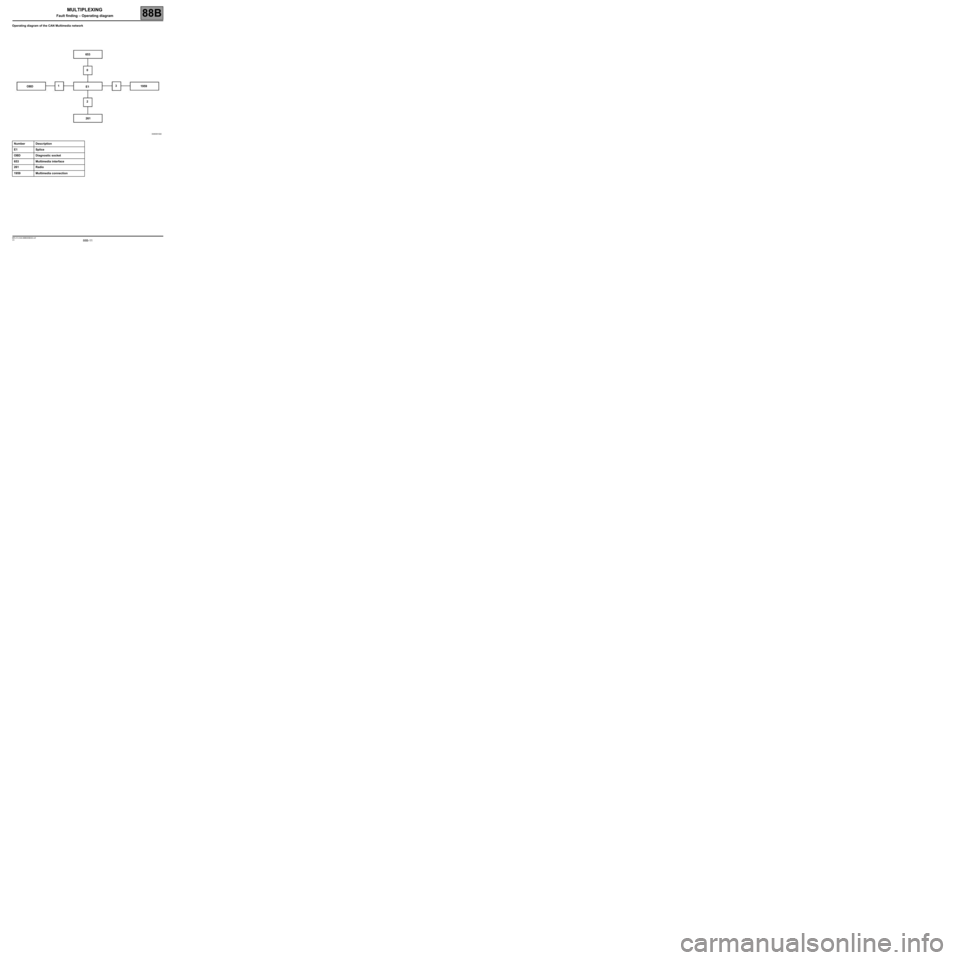
88B-11V3 MR-413-X44-88B000$030.mif
MULTIPLEXING
Fault finding – Operating diagram88B
Operating diagram of the CAN Multimedia network
Number Description
E1 Splice
OBD Diagnostic socket
653 Multimedia interface
261 Radio
1959 Multimedia connection
OBD653
0
1
23
E1
2611959
Page 12 of 33
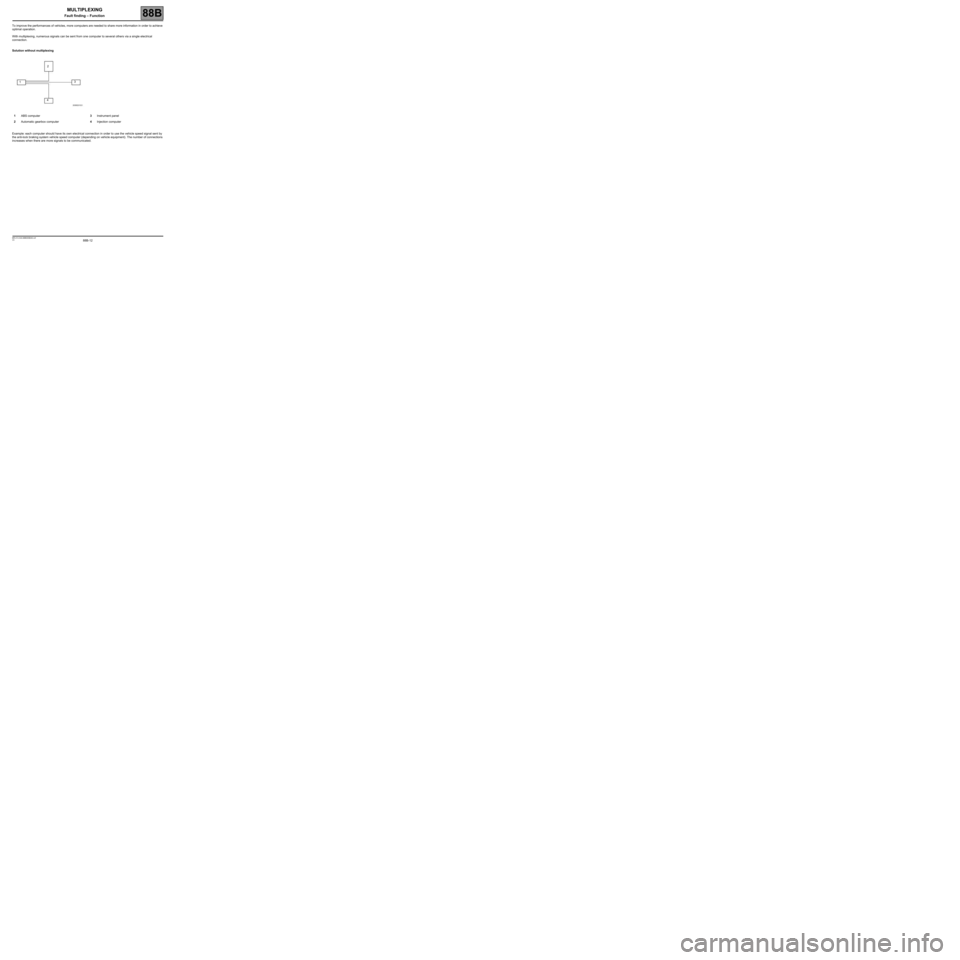
88B-12V3 MR-413-X44-88B000$040.mif
88B
To improve the performances of vehicles, more computers are needed to share more information in order to achieve
optimal operation.
With multiplexing, numerous signals can be sent from one computer to several others via a single electrical
connection.
Solution without multiplexing
Example: each computer should have its own electrical connection in order to use the vehicle speed signal sent by
the anti-lock braking system vehicle speed computer (depending on vehicle equipment). The number of connections
increases when there are more signals to be communicated.1ABS computer3Instrument panel
2Automatic gearbox computer4Injection computer
12
3
4
MULTIPLEXING
Fault finding – Function
Page 13 of 33
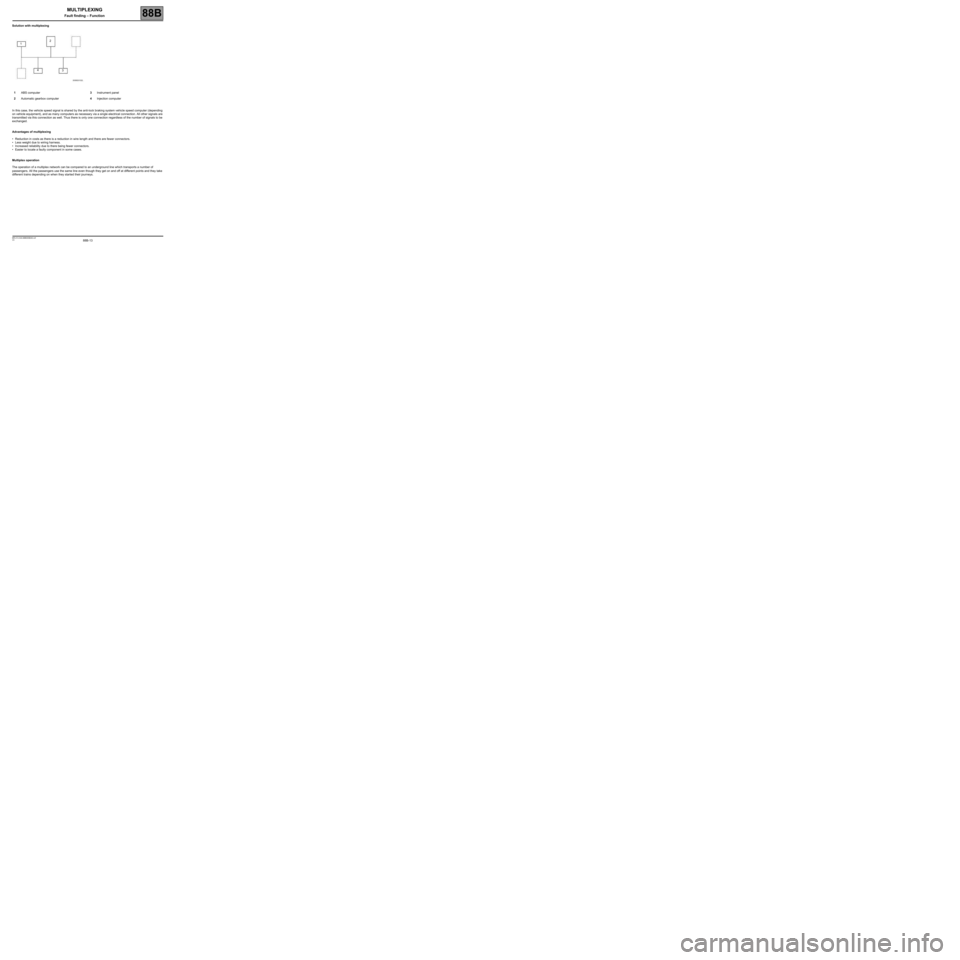
88B-13V3 MR-413-X44-88B000$040.mif
MULTIPLEXING
Fault finding – Function88B
Solution with multiplexing
In this case, the vehicle speed signal is shared by the anti-lock braking system vehicle speed computer (depending
on vehicle equipment), and as many computers as necessary via a single electrical connection. All other signals are
transmitted via this connection as well. Thus there is only one connection regardless of the number of signals to be
exchanged.
Advantages of multiplexing
•Reduction in costs as there is a reduction in wire length and there are fewer connectors.
•Less weight due to wiring harness.
•Increased reliability due to there being fewer connectors.
•Easier to locate a faulty component in some cases.
Multiplex operation
The operation of a multiplex network can be compared to an underground line which transports a number of
passengers. All the passengers use the same line even though they get on and off at different points and they take
different trains depending on when they started their journeys.1ABS computer3Instrument panel
2Automatic gearbox computer4Injection computer
12
3 4
Page 14 of 33
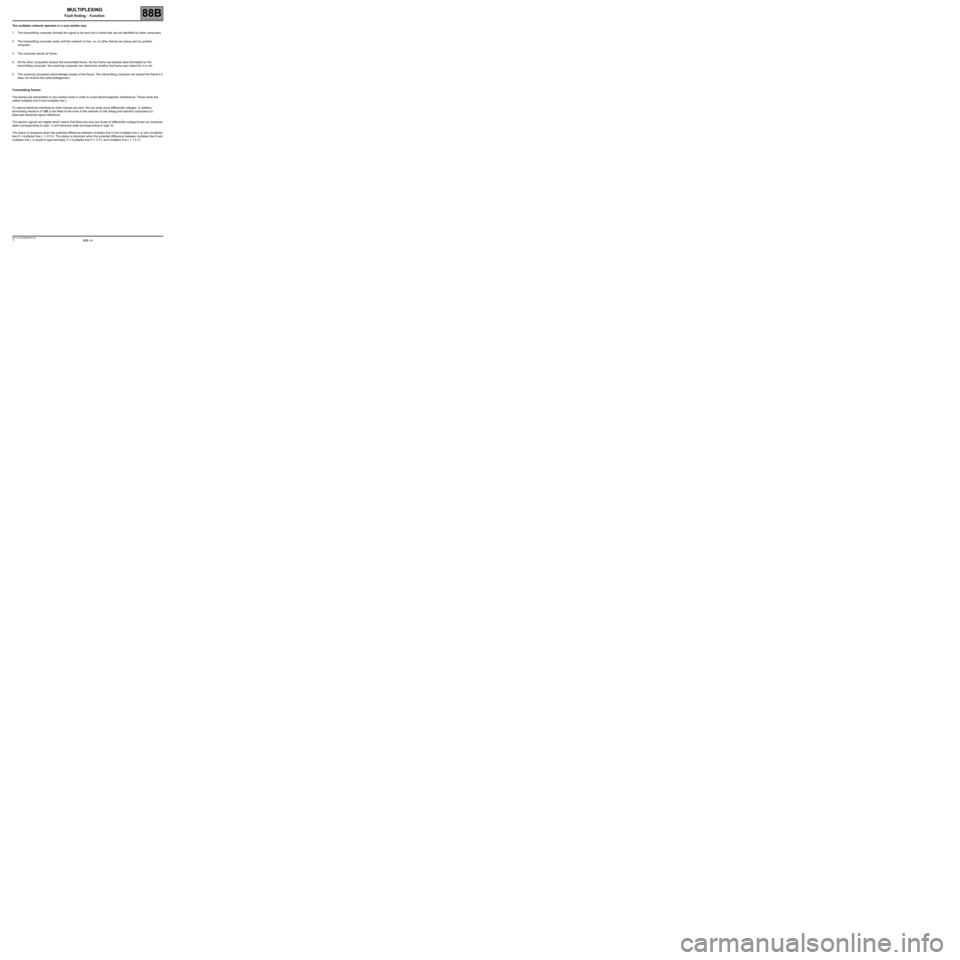
88B-14V3 MR-413-X44-88B000$040.mif
MULTIPLEXING
Fault finding – Function88B
The multiplex network operates in a very similar way.
1. The transmitting computer formats the signal to be sent into a frame that can be identified by other computers.
2. The transmitting computer waits until the network is free, i.e. no other frames are being sent by another
computer.
3. The computer sends its frame.
4. All the other computers receive the transmitted frame. As the frame has already been formatted by the
transmitting computer, the receiving computer can determine whether the frame was meant for it or not.
5. The receiving computers acknowledge receipt of the frame. The transmitting computer will resend the frame if it
does not receive this acknowledgement.
Transmitting frames
The frames are transmitted on two twisted wires in order to avoid electromagnetic interference. These wires are
called multiplex line H and multiplex line L.
To reduce electrical interference when frames are sent, the two wires have differential voltages. In addition,
terminating resistors of 120 Ω are fitted at the ends of the network (in the airbag and injection computers) to
attenuate electrical signal reflections.
The electric signals are digital which means that there are only two levels of differential voltage known as recessive
state (corresponding to logic 1) and dominant state (corresponding to logic 0).
The status is recessive when the potential difference between multiplex line H and multiplex line L is zero (multiplex
line H = multiplex line L = 2.5 V). The status is dominant when the potential difference between multiplex line H and
multiplex line L is equal to approximately 2 V (multiplex line H = 3.5 V and multiplex line L = 1.5 V).
Page 15 of 33
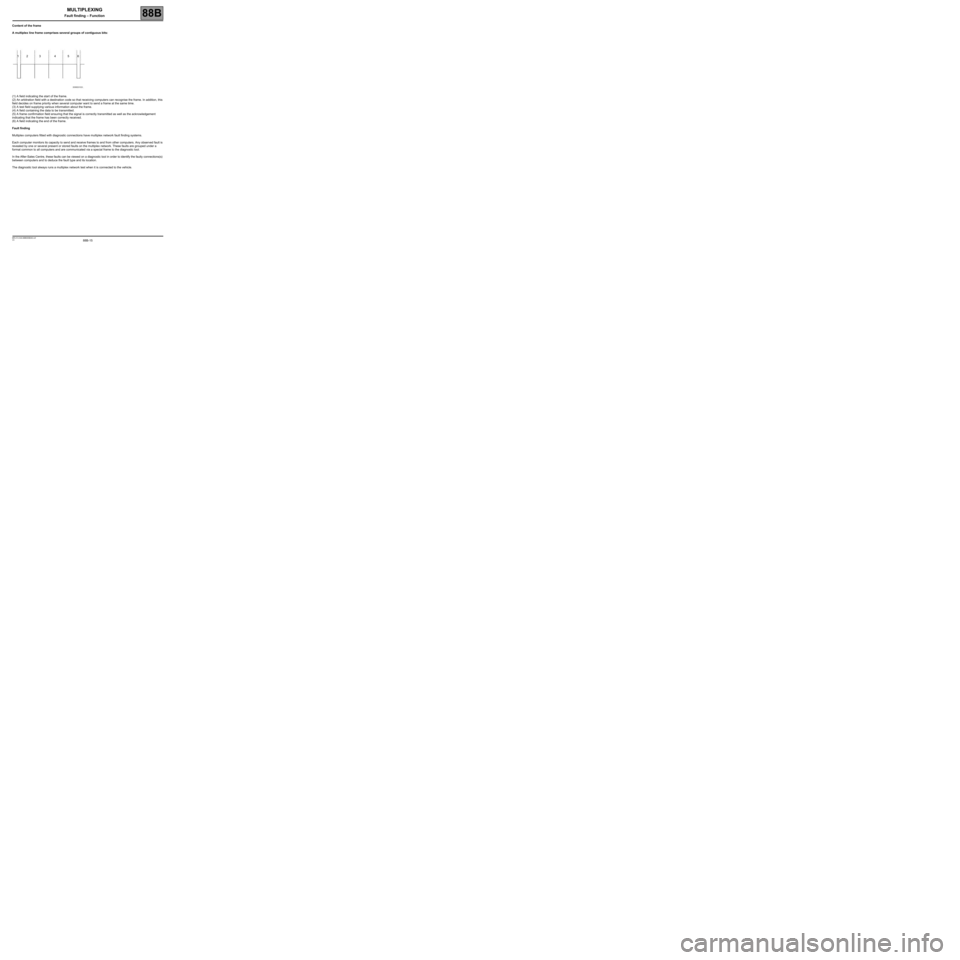
88B-15V3 MR-413-X44-88B000$040.mif
MULTIPLEXING
Fault finding – Function88B
Content of the frame
A multiplex line frame comprises several groups of contiguous bits:
(1) A field indicating the start of the frame.
(2) An arbitration field with a destination code so that receiving computers can recognise the frame. In addition, this
field decides on frame priority when several computer want to send a frame at the same time.
(3) A test field supplying various information about the frame.
(4) A field containing the data to be transmitted.
(5) A frame confirmation field ensuring that the signal is correctly transmitted as well as the acknowledgement
indicating that the frame has been correctly received.
(6) A field indicating the end of the frame.
Fault finding
Multiplex computers fitted with diagnostic connections have multiplex network fault finding systems.
Each computer monitors its capacity to send and receive frames to and from other computers. Any observed fault is
revealed by one or several present or stored faults on the multiplex network. These faults are grouped under a
format common to all computers and are communicated via a special frame to the diagnostic tool.
In the After-Sales Centre, these faults can be viewed on a diagnostic tool in order to identify the faulty connections(s)
between computers and to deduce the fault type and its location.
The diagnostic tool always runs a multiplex network test when it is connected to the vehicle.
12 3 4 5 6
Page 16 of 33

88B-16V3 MR-413-X44-88B000$050.mif
88B
The multiplexing function does not have a safe mode program.
However, the multiplexing function may have special operation features.
The multiplex network still functions when multiplex line L is in short circuit to earth. The voltage in multiplex line H is
identical to that in multiplex line L.
MULTIPLEXING
Fault finding – Defect and safe modes
Page 17 of 33

88B-17V3 MR-413-X44-88B000$060.mif
88B
MULTIPLEX NETWORK CONFIGURATION
For the
CAN Vehicle network:
The tool displays the UCH and/or Airbag configurations.
The Configuration screen consists of two tabs for displaying and modifying the:
–The first tab, Multiplex network configuration, indicates the multiplex network version and the list of computers
defined as present on the multiplex network.
–The second tab, Configuration of computers which support fault finding, indicates the relevant diagram
number, and the list of computers defined as supporting fault finding with the RENAULT tool.
First repair the computers containing the multiplex network configuration (Airbag and UCH) in order to
display the screen with the multiplex network configuration diagram for the vehicle on which fault finding is
being run.
For the
CAN Multimedia network:
The tool presents the configuration of the A2/A3 display.
The Configuration screen consists of two tabs for displaying and modifying the:
–The first tab, Multiplex network configuration, indicates the multiplex network version and the list of computers
defined as present on the multiplex network.
–The second tab, Configuration of computers which support fault finding, indicates the relevant diagram
number, and the list of computers defined as supporting fault finding with the RENAULT tool.
NOTESThe configuration is entered with the ignition on; apply the forced + after ignition
feed procedure (see Introduction).
It can be run from the multiplex network test results screens.
WARNING: the network version number is 1.
This is the diagram version which changes each time the multiplex network wiring is modified on this vehicle.
WARNING: the network version number is 1.
This is the diagram version which changes each time the multiplex network wiring is modified on this vehicle.
MULTIPLEXING
Fault finding – Configuration
Page 18 of 33
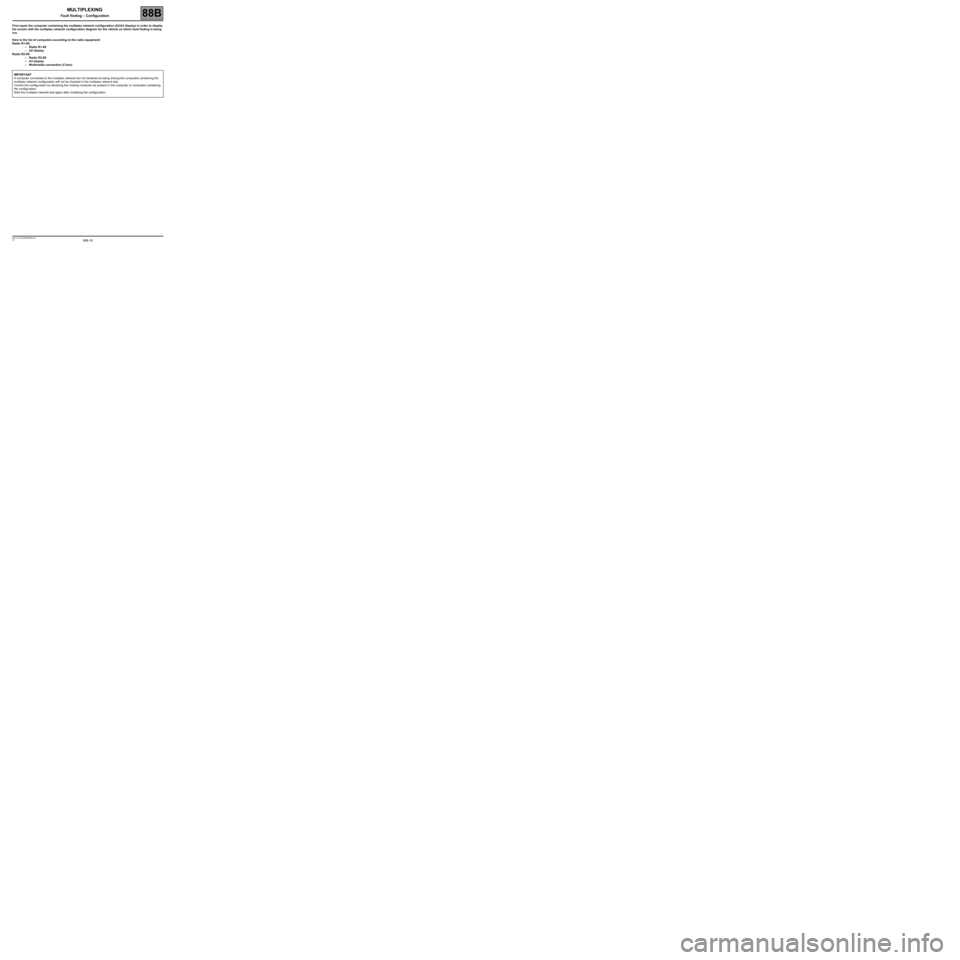
88B-18V3 MR-413-X44-88B000$060.mif
MULTIPLEXING
Fault finding – Configuration88B
First repair the computer containing the multiplex network configuration (A2/A3 display) in order to display
the screen with the multiplex network configuration diagram for the vehicle on which fault finding is being
run.
Here is the list of computers according to the radio equipment:
Radio R1-08:
–Radio R1-08
–A2 display
Radio R2-08:
–Radio R2-08
–A3 display
–Multimedia connection (C-box)
IMPORTANT
A computer connected to the multiplex network but not declared as being among the computers containing the
multiplex network configuration will not be checked in the multiplex network test.
Correct the configuration by declaring the missing computer as present in the computer or computers containing
the configuration.
Start the multiplex network test again after modifying the configuration.
Page 19 of 33
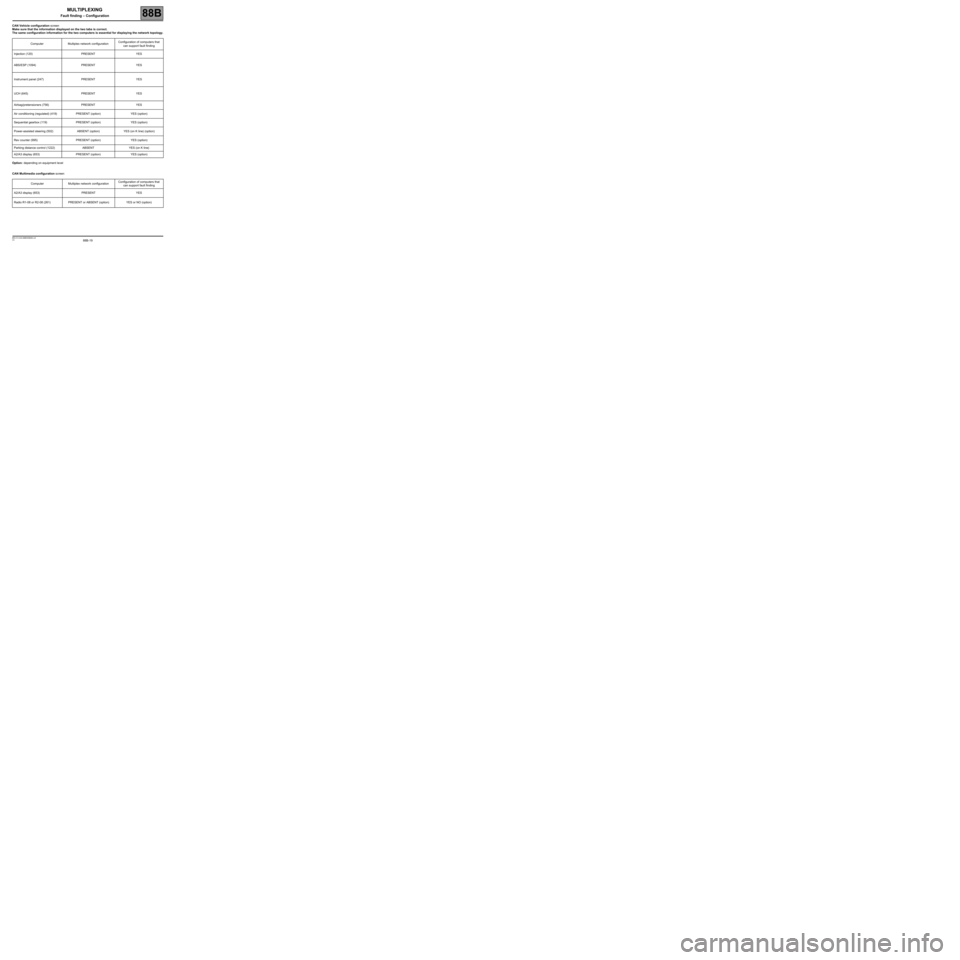
88B-19V3 MR-413-X44-88B000$060.mif
MULTIPLEXING
Fault finding – Configuration88B
CAN Vehicle configuration screen
Make sure that the information displayed on the two tabs is correct.
The same configuration information for the two computers is essential for displaying the network topology.
Option: depending on equipment level
CAN Multimedia configuration screen Computer Multiplex network configurationConfiguration of computers that
can support fault finding
Injection (120) PRESENT YES
ABS/ESP (1094) PRESENT YES
Instrument panel (247) PRESENT YES
UCH (645) PRESENT YES
Airbag/pretensioners (756) PRESENT YES
Air conditioning (regulated) (419) PRESENT (option) YES (option)
Sequential gearbox (119) PRESENT (option) YES (option)
Power-assisted steering (502) ABSENT (option) YES (on K line) (option)
Rev counter (995) PRESENT (option) YES (option)
Parking distance control (1222) ABSENT YES (on K line)
A2/A3 display (653) PRESENT (option) YES (option)
Computer Multiplex network configurationConfiguration of computers that
can support fault finding
A2/A3 display (653) PRESENT YES
Radio R1-08 or R2-08 (261) PRESENT or ABSENT (option) YES or NO (option)
Page 20 of 33
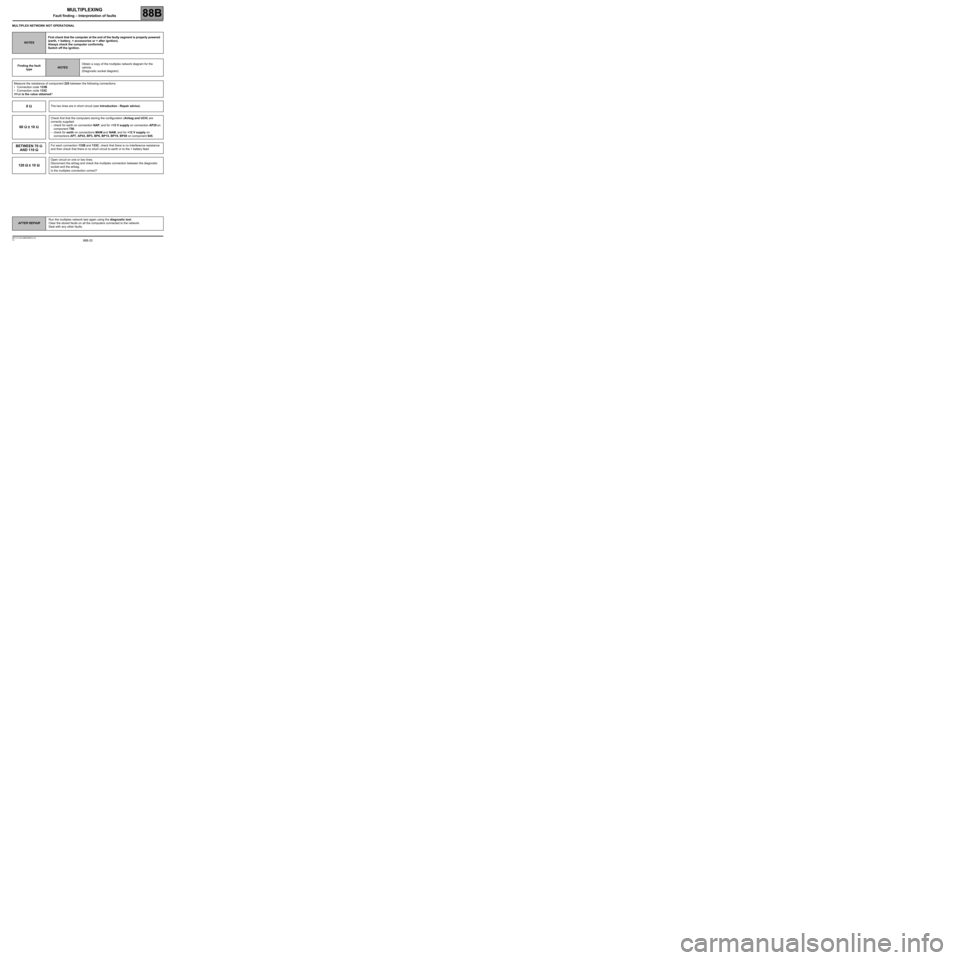
88B-20
AFTER REPAIRRun the multiplex network test again using the diagnostic tool.
Clear the stored faults on all the computers connected to the network.
Deal with any other faults.
V3 MR-413-X44-88B000$070.mif
88B
MULTIPLEX NETWORK NOT OPERATIONAL
NOTESFirst check that the computer at the end of the faulty segment is properly powered
(earth, + battery, + accessories or + after ignition).
Always check the computer conformity.
Switch off the ignition.
Finding the fault
type
NOTESObtain a copy of the multiplex network diagram for the
vehicle.
(Diagnostic socket diagram).
Measure the resistance of component 225 between the following connections:
•Connection code 133B
•Connection code 133C
What is the value obtained?
0 ΩΩ Ω ΩThe two lines are in short circuit (see Introduction - Repair advice).
60 ΩΩ Ω Ω
± 10 ΩΩ Ω Ω
Check first that the computers storing the configuration (Airbag and UCH) are
correctly supplied:
–check for earth on connection NAP, and for +12 V supply on connection AP25 on
component 756.
–check for earth on connections MAM and NAM, and for +12 V supply on
connections AP7, AP43, BP3, BP6, BP15, BP19, BP49 on component 645.
BETWEEN 70 ΩΩ Ω Ω
AND 110 ΩΩ Ω ΩFor each connection 133B and 133C, check that there is no interference resistance
and then check that there is no short circuit to earth or to the + battery feed.
120 ΩΩ Ω Ω
± 10 ΩΩ Ω Ω
Open circuit on one or two lines.
Disconnect the airbag and check the multiplex connection between the diagnostic
socket and the airbag.
Is the multiplex connection correct?
MULTIPLEXING
Fault finding – Interpretation of faults